EMD F-unit
EMD F-units were a line of diesel-electric locomotives produced between November 1939 and November 1960 by General Motors Electro-Motive Division and General Motors-Diesel Division. Final assembly for all F-units was at the GM-EMD plant at La Grange, Illinois, and the GMDD plant in London, Ontario, Canada. They were sold to railroads throughout the United States, Canada, Mexico and a few were exported to Saudi Arabia. The term F-unit refers to the model numbers given to each successive type (i.e. F3, F7, etc.), all of which began with the letter F. The "F" originally meant Fourteen, as in 1,400 horsepower, not F as in Freight. Longer EMD E-units for passenger service had twin 900 horsepower diesel engines (called "prime movers" in this type of application). The "E" meant Eighteen as in 1,800 horsepower. Similarly, for early model EMD switchers "S" meant Six hundred and "N" meant Nine hundred horsepower.
.jpg.webp)
F-units were originally designed for freight service – although many without steam generators (for steam-heating passenger cars) pulled short-distance, mainly daytime passenger trains. Some carriers even equipped small numbers of their Fs with steam generators for long-haul passenger service. On the other hand, Santa Fe maintained a large fleet of fully equipped, high-speed F3s and F7s in "warbonnet" paint schemes built exclusively for top-tier passenger trains, such as the "Chief", "Super Chief", and "El Capitan". Almost all F-units were B-B locomotives, meaning that they ran on two Blomberg B two-axle trucks with all axles powered. The prime mover in F-units was a sixteen-cylinder EMD 567 series mechanically aspirated two-stroke diesel engine, progressing from model 16-567 through 16-567D.
Structurally, the locomotive was a carbody unit, with the body as the main load-bearing structure, designed like a bridge truss and covered with cosmetic panels. The so-called bulldog nose was a distinguishing feature of the locomotive's appearance, and made a lasting impression in the mind of the traveling public.
The F-units were the most successful "first generation" road (main line) diesel locomotives in North America, and were largely responsible for superseding steam locomotives in road freight service. Before this, diesel units were mostly only built as switcher locomotives, and only used in rail yards.
F-units were sometimes known as "covered wagons",[1] due to the similarity in appearance of the roof of an F-unit to the canvas roof of a Conestoga wagon, an animal-drawn wagon used in the westward expansion of the United States during the late 18th and 19th centuries. When a train's locomotive included only F-units, the train would then be called a wagon train. These two usages are still popular with the railfan community.
Models
| Model designation | Build year | Total produced | AAR wheel arrangement | Prime mover | Power output | Image |
|---|---|---|---|---|---|---|
| FT | 1939–1945 | 555 A units, 541 B units |
B-B (B-B+B-B with B unit) |
EMD 16-567 EMD 16-567A |
2,700 hp (with B unit) |
 |
| F2 | 1946 | 74 A units, 30 B units |
B-B | EMD 16-567B | 1,350 hp (1000 kW) |
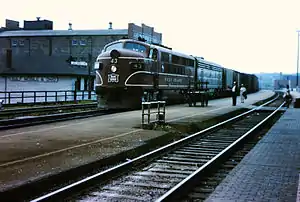 |
| F3 | 1946–1949 | 1,111 A units, 696 B units |
B-B | EMD 16-567B | 1,500 hp (1,100 kW) |
 |
| F7 | 1949–1953 | 2,366 A units, 1,483 B units |
B-B | EMD 16-567B | 1,500 hp (1,100 kW) |
.jpg.webp) |
| FP7 | 1949–1953 | 381 A units, no B units |
B-B | EMD 567B | 1,500 hp (1,200 kW) |
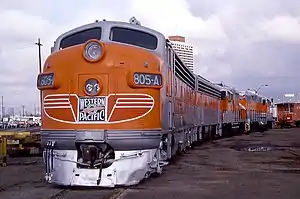 |
| F9 | 1953–1960 | 99 A units, 156 B units |
B-B | EMD 16-567C | 1,750 hp (1200 kW) |
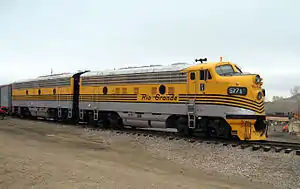 |
| FP9 | 1954–1959 | 90 A units, no B units |
B-B | EMD 567C | 1,750 hp (1,300 kW) |
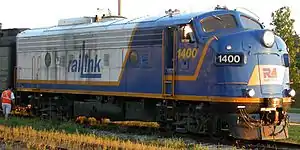 |
| FL9 | 1956–1960 | 60 A units, no B units |
B-A1A | EMD 567C or EMD 567D1; plus 660 V DC (3rd rail) |
567C: 1,750 hp (1,300 kW); 567D1: 1,800 hp (1,340 kW) | 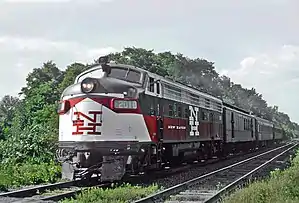 |
Model development
The FT, introduced in 1939 with the new 1,350 hp (1.01 MW) 567 engine and Blomberg B trucks, was a successful design, and remained in production during WWII.
The F3 (1946) had a different roof arrangement that included the replacement of the FT's boxy dynamic brake structure with two under-roof grids, two exhaust stacks instead of four, and four cooling fans grouped together instead of separated pairs of cooling fans. The F3 was also two feet longer than the FT to allow a standard draft gear to be installed at the rear of the unit. The 567B engine was uprated to 1,500 hp (1.1 MW). Some F3s were nicknamed "chickenwire" for the type of engine room air-intake structure along the sides.
The F7 (1949) and F9 (1954) were evolutionary: the F7 had improved traction motors, the F9 a 1,750 hp (1.30 MW) 567C engine. A louver arrangement over the vents changed their appearance from the F3.
There were also 4 foot longer versions, the FP7 and FP9, with the extra length to house a tank for extra water capacity. Only one F model did not have Blomberg B trucks: the FL9 had a lightweight Flexicoil B in front and a standard passenger A-1-A at the rear.
Model descriptions are as built; EMC/EMD locomotives are often rebuilt to newer standards. [2] [3]
In the May 2014 issue of Trains Magazine at page 10 is an article by Chris Guss concerning freight and current use of the EMD F Unit.
Engine and powertrain
The F series used a 16-cylinder version of the 567 series diesel engine, introduced in 1939. The 567 was designed specifically for railroad locomotives, a mechanically aspirated 2 stroke 45 degree V type with 567 cu in (9.29 L) displacement per cylinder, for a total of 9,072 cu in (148.66 L). An ongoing engine improvement program saw the FT’s original 1,350 hp (1.01 MW) up-rated to 1,800 hp (1.3 MW) in the FL9 by the end of F unit production. A DC generator powered four traction motors, two on each truck. The Blomberg B truck first used in the FT became the EMD production standard, being used through 1995. EMC/EMD has built all of its major components since 1939[3][4]
Passenger service
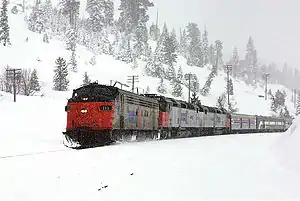
While the F-unit series was originally conceived for freight service, many were used to haul passenger trains. The original EMC FT demonstrator was equipped with a steam generator in the B units for train heating. Several railroads took advantage of the large space in the rear of their B units to add steam generators. The first FTs built strictly as a passenger unit was the Santa Fe 167 four unit set in February 1945. Learning from this, EMD offered an optional steam generator on all later F unit models. This was mounted at the rear of the carbody; steam-generator equipped locomotives can be recognised by the exhaust stack and safety valves protruding at the rear of the roof.
The F units were popular passenger locomotives on mountain grades (where they were recommended by EMD), because a four-unit set had more motored axles than a trio of E-units of equivalent power (sixteen versus twelve) and thus had less chance of overloading the traction motors. Additionally, that 4-unit F set had all its weight on driven wheels and was thereby capable of greater tractive effort. The AT&SF Super Chief, CB&Q/D&RGW/WP California Zephyr, and GN Empire Builder all used F units on their Chicago-West Coast routes in the 1950s. The F7 was also popular for commuter lines and other passenger service where the trains were short.
Options
There were several options that could be specified by customers, such as type and mounting location of horns, bells, and the like.
Dynamic brakes
Dynamic brakes were an option on F units ordered by railroads with mountainous terrain and steep grades.
Passenger or freight pilot
Either a passenger or freight style pilot could be ordered. The passenger pilot, similar to that standard on EMD E units, sloped smoothly down from the bottom of the nose, making a single slope all the way down from the headlight. The coupler was retractable with concealing doors. The result was a very attractive appearance that enhanced the impression of a powerful and speedy machine.
The freight pilot curved inward a little way below the bottom of the nose before sloping out again, to give more clearance to the coupler and hoses. The coupler was fixed and protruded through a rectangular opening in the pilot.
See also
- CF7 - A rebuild of an EMD F unit by the Atchison, Topeka and Santa Fe Railway.
References
- See, e. g., Young, William S. "Covered Wagons: The Early Road Diesels of the Erie Lackawanna" (1976, Starrucca Valley Publications).
- Pinkpank, Jerry A (1973). The Second Diesel Spotter’s Guide. Kalmbach Books. pp. 13, 26 90–95, 99–101. ISBN 0-89024-026-4.
- Ross, David, ed. (2003). The Encyclopedia of Trains and Locomotives. pp. 270–271, 295. ISBN 978-0-7607-9679-5.
- Pinkpank, Jerry A (1973). The Second Diesel Spotter’s Guide. Kalmbach Books. pp. 13, 26. ISBN 0-89024-026-4.
- Diesel Era (1994). The Revolutionary Diesel: EMC's FT. Halifax, PA, USA: Withers Publishing. ISBN 1-881411-02-8.
- Lamb, J. Parker (2007). Evolution of the American Diesel Locomotive. Railroads Past and Present. Bloomington, Indiana: Indiana University Press. ISBN 978-0-253-34863-0.
- Marre, Louis A. (1995). Diesel Locomotives: The First 50 Years: A Guide to Diesels Built Before 1972. Railroad Reference Series. Waukesha, Wisconsin: Kalmbach Publishing. ISBN 978-0-89024-258-2.
- Pinkepank, Jerry A. (1973). The Second Diesel Spotter's Guide. Milwaukee, Wisconsin: Kalmbach Publishing. ISBN 978-0-89024-026-7.
- Schafer, Mike (1998). Vintage Diesel Locomotives. Enthusiast Color Series. Osceola, Wisconsin: MBI Publishing. ISBN 978-0-7603-0507-2.
- Solomon, Brian (2000). The American Diesel Locomotive. Osceola, Wisconsin: MBI Publishing Company. ISBN 978-0-7603-0666-6.
- Solomon, Brian (2005). EMD F-Unit Locomotives. North Branch, Minnesota: Specialty Press. ISBN 978-1-58007-192-5.
- Solomon, Brian (2006). EMD Locomotives. St. Paul, Minnesota: Voyageur Press. ISBN 978-0-7603-2396-0.
- Solomon, Brian (2010). Vintage Diesel Power. Minneapolis, Minnesota: MBI Publishing. ISBN 978-0-7603-3795-0.
- Solomon, Brian (2011). Electro-Motive E-Units and F-Units: The Illustrated History of North America's Favorite Locomotives. Minneapolis, Minnesota: Voyageur Press. ISBN 978-0-7603-4007-3.
- Solomon, Brian (2012). North American Locomotives: A Railroad-by-Railroad Photohistory. Minneapolis, Minnesota: Voyageur Press. ISBN 978-0-7603-4370-8.
- Wilson, Jeff (1999). F Units: The Diesels That Did It. Golden Years of Railroading. Waukesha, Wisconsin: Kalmbach Publishing. ISBN 978-0-89024-374-9.
